- Home
- Symmetry Blog
- Which LPWAN Protocol Do You Need?
Which LPWAN Protocol Do You Need?
Licensed vs. Unlicensed
About Jari Haiston
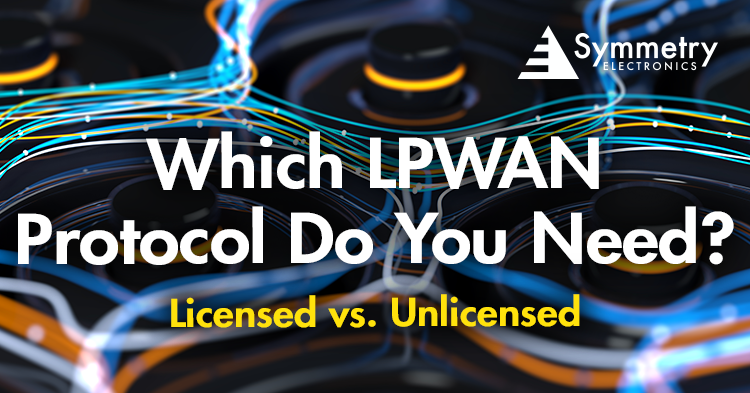
What is an LPWAN?
A Low Power Wide Area Network (LPWAN) is designed for machine-to-machine environments. A Global Newswire report predicts that the “U.S. LPWAN market size is expected to grow beyond $20 billion by 2027, thanks to the rising IoT deployment across manufacturing facilities.” Convenient in its inherent low power, long-range, and low-cost design, LPWAN operates in two formats: licensed and unlicensed (Figure 1).
Known for its low data transfer rates and low power consumption, LPWAN-enabled devices include applications in smart cities, smart lighting, asset monitoring, asset tracking, manufacturing, precision agriculture, livestock monitoring, and applications within the industrial internet of things (IIoT) market. Developers should consider the following when determining the optimal protocol for their intended use case(s):
- Technology fit (battery performance, throughput, mobility requirements, transmission frequency, spectrum, etc.)
- Operational impact (coverage, deployment time, quality of service, etc.)
- Business relevance (time to market, device operator, etc.)
Licensed LPWAN vs. Unlicensed LPWAN
Licensed LPWAN operates on public networks and is an optimal connectivity solution for mobile devices requiring seamless transition between networks. Supporting GSM and 3GPP standards, over 900 mobile operators offer and support licensed LPWAN networking. Licensed LPWAN is a secure and reliable solution in its exclusive connection. Type of licensed LPWAN-based technology include Narrowband IoT (NB-IoT) and Long Term Evolution for Machines (LTE-M).
NB-IoT is a sustainable mobile data standard for LPWAN that reuses Global System for Mobile (GSM) carrier waves. With data rates of up to 250 Kpbs, NB-IoT-enabled devices are ideal for lower bandwidth applications. Devices that incorporate NB-IoT technology benefit from NB-IoT’s 10+ years of battery life, enhanced range, advanced barrier penetration, and low power consumption.
LTE-M technology connects enabled devices directly to 4G networks. Boasting low latency, high speeds, and enhanced reliability, LTE-M is a powerful form of technology for mobile use cases. LTE-M technology is a cost-effective connectivity solution as the half-duplex chips used to connect LTE-M devices to 4G networks are less expensive than those used in NB-IoT. Service rates surrounding LTE-M are also efficient as data rates are variable.
Figure 1: Licensed vs. Unlicensed LPWAN technologies
Source : Schneider Electric
Unlike licensed LPWAN, unlicensed LPWAN is suited for applications in smaller environments where mobility is not a requirement or in applications where public LPWAN networks are unavailable. Unlicensed LPWAN is an ideal solution in applications like rural farming Operating on unlicensed radio spectrum, the advantage of unlicensed LPWAN surrounds the accessibility of establishing private networks with ease. However, unlicensed LPWAN networks can prove to be less secure as any entity or organization can use the same spectrum for a different network. Types of unlicensed LPWAN-based technologies include LoRaWAN® and Sigfox.
A LoRaWAN gateway lies at the center of LoRa® deployment. LoRaWAN gateways are routers that collect data and transmit data from sensors and devices. Providing public and private networking solutions, LoRaWAN gateways are capable of supporting thousands of devices. Developers are also able to utilize multiple gateways to penetrate harder to reach environments and ensure resiliency in the event of gateway failure.
Sigfox is a low cost and low power connectivity solution that can be combined with complementary technology like Bluetooth, global positions systems (GPS), and Wi-Fi to enhance its features. Sigfox is suited for devices that transmit data infrequently and is uplink only. Sigfox also has a limited area where the technology is deployed.
Low Power Wide Area Network (LPWAN) Use Cases & Applications:
With applications pertaining heavily in IoT and IIoT industries (Figure 2), LPWAN technology is an essential connectivity tool. According to IoT Analytics, China dominates the market for the highest LPWAN integration through NB-IoT technology. In 2020, China held 80% of global connections. However, innovative use cases are popping up for LPWAN across the globe. In the UK, the city of Southampton was used as a testing ground for LPWAN-enabled air quality monitoring. Through the use of LoRaWAN architecture, the city was able to log, transmit, and store continuous amounts of information on a real-time scale to track city-wide averages in air quality.
BEHR Tech has also cited compelling use cases for LPWAN in auto manufacturing like process optimization through environmental monitoring, predictive maintenance, and worker safety. Through sensors and other IoT deployment, LPWAN technology can help maintain optimal operating conditions for all manufacturing processes. Predictive maintenance is a core pillar of industry 4.0 and can be enabled by LPWAN. Additionally, LPWAN is the most cost-effective option for integrating predictive maintenance into manufacturing processes. Utilizing LPWAN-enabled sensors and wearables ensures workplace safety in that companies can track the health of their employees around the clock.
Figure 2: Common LPWAN-based applications
Source: ResearchGate
When considering what LPWAN protocol is optimal for your device, consider consulting with experts at Symmetry Electronics! As a member of the, Lora Alliance®, our experts can assist you with any questions you may have about LPWAN integration in your devices. Contact us today!

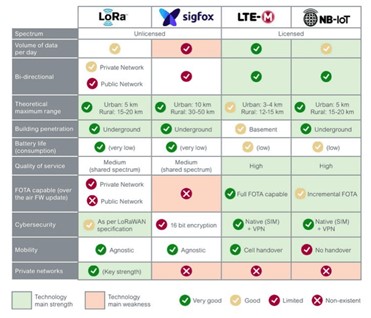
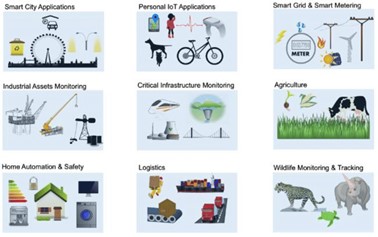
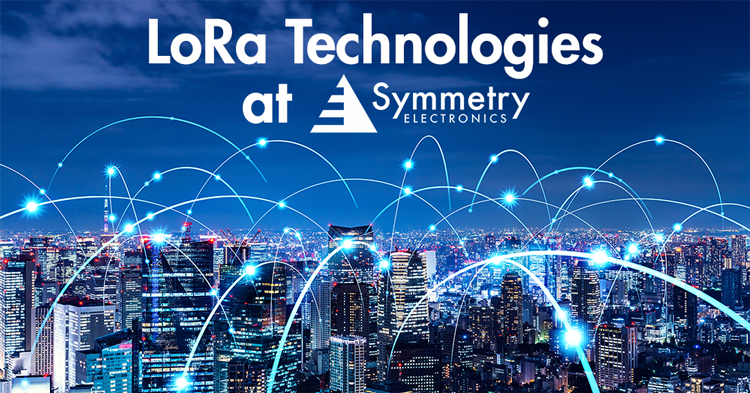

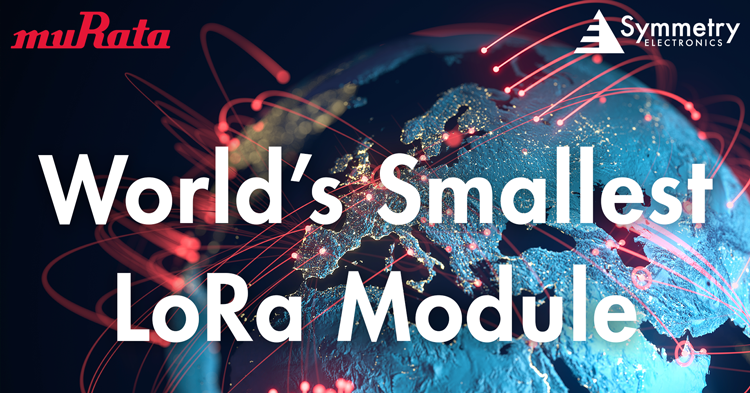
.jpg)